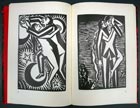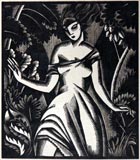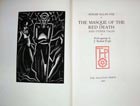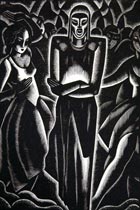Cabinet 03
 |
While living in Brussels, at rue Edith Cavelle, JBW set about teaching himself wood and copper engraving. He was fortunate to reside there in the 1920's. Belgium and nearby Holland had a bustling art community, which included writers and artists such as Maeterlinck, Francis Jammes, Waldemar George, Fritz van den Berge, Gustave de Smet, Josef Peeters, and Henri Le Fauconnier. There was also the Parisian set: Matisse, Derain, Picasso, who often exhibited at Belgian galleries. JBW was attached to De Vijf, a group of wood-block printers influenced by Edward Pellens, the father of the 20th century Belgian woodcut. One dominant member was Franz Masereel (1889-1972), a woodcut artist who was a pacifist in World War I. Here are images from his Laster und Leidenschaft (Vice and Passion), a compilation of Masereel's graphic works. Frans Masereel, Laster und Leidenschaft. Hanau: Karl Schustek, 1968. Brasch NE 115.5 M37 A69 1967. |
 |
'In my office appeared a tall, young Englishman, slightly nervous about the meeting he was imagining, with a probably bearded Belgian publisher of about 60 years old, who would give him the assignment to make a few wood engravings for a minimal honorarium or that would politely send him away after a few words.' So recalled Alexander A. Stols (1900-1973), the director of the Maastricht-based Halcyon Press, on first meeting JBW. It was a successful meeting, with JBW commissioned to illustrate a limited edition book of John Keats's Sonnets (1930), his first published engravings. This is one of eleven prints from that debut publication. Illustration to poem 'To G. A. W.' from John Keats, The Collected Sonnets. Maastricht: Halcyon Press, 1930. Private Collection. |
  |
The Stols-JBW relationship was a fruitful one. Between 1930 and 1940, Halcyon Press published over a dozen books illustrated by JBW. The eighth book for Halcyon was Poe's The Masque of the Red Death, with JBW completing the engravings at his studio in Buttes Chaumont, Paris. Later he and his wife Mary would move to 9 bis rue de Valence in the Latin Quarter; their residence until the outbreak of World War II. It was an ideal apartment, having a separate room for a work-space and an abundance of northern light by which he could work. Edgar Allan Poe, The Masque of the Red Death and Other Tales. Maastricht: Halcyon Press, 1932. Special PS 2612 A1 1932. |
| «Previous | Next» |
